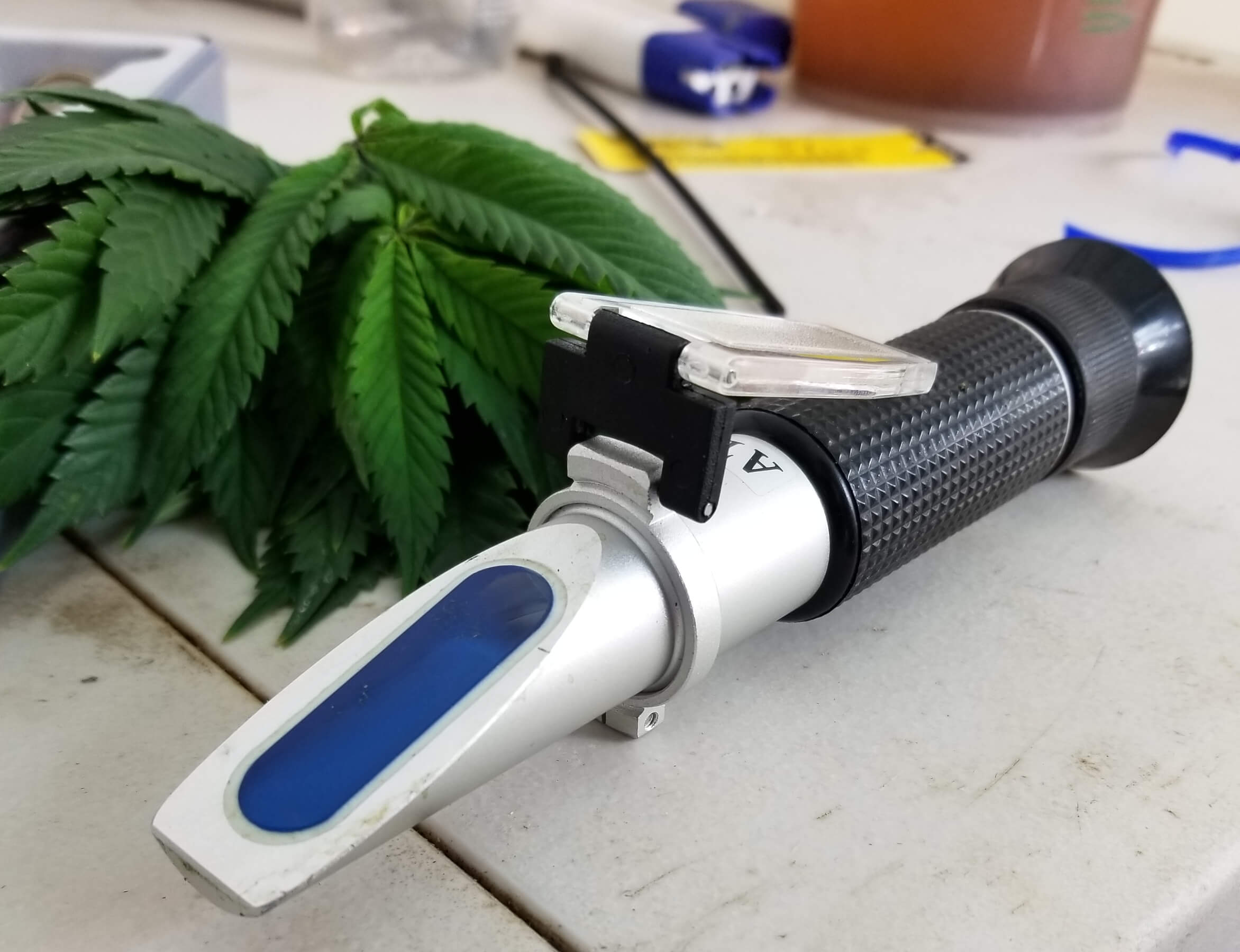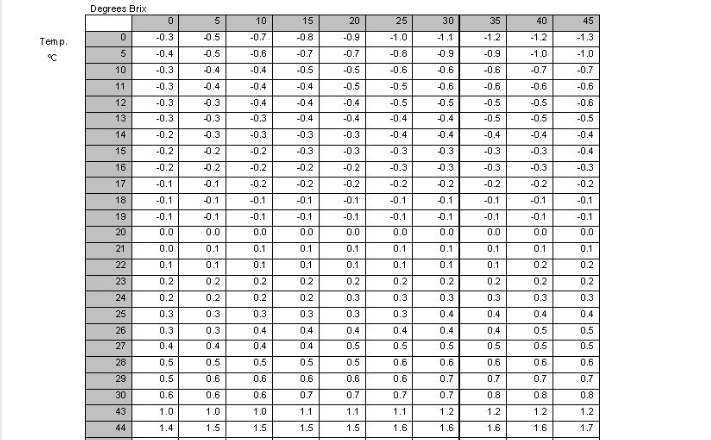- Brix - A Refractive Index
- Refractometer Basics
- Refractometer Calibration
- Measuring Brix with Optical Refractometers

Brix - A Refractive Index
Brix (pronounced “bricks”) is a scale of measurement (°Bx) used to estimate the amount of sucrose and other water soluble content in plant sap, but it has other industrial uses as well. It was discovered by a German chemist named Professor A.F.W. Brix in the 19th century and was subsequently named after him. The measurement has proven especially useful to winemakers who would test the quality of their grapes prior to processing in order to estimate the quality of juices the grapes would produce for their wine. Now, brix is used to test the taste quality of a wide range of beverages from wine to soda using a variety of techniques based on sucrose levels. There is also a growing number of farmers who test their crops for brix to also measure the taste quality of their produce and refer to the Refractive Index of Crop Juices to estimate the possible quality of their produce. Based on brix tests on healthy cannabis plants that have produced a high quality product, a reading of 20 brix would be considered a healthy cannabis plant, but a lower brix reading does not give any direct indication as to what could be adversely affecting the plant whether its pest pressure, disease, water stress, or any other potential issues. That is why brix should not be used as the sole variable to estimate the health of a plant. Even though brix does measure sucrose levels in plant sap, it also indirectly measures minerals, proteins, and lipids because these can contribute to a brix reading. A brix reading is only one small component in measuring the health of a plant. Instead, analysis of nutrients being used, nutrient schedules, irrigation schedules, environment, and visual examinations of plants along with a brix reading can provide a more accurate picture of the health of a plant.
Refractometer Basics
There is a simple instrument that can be used to estimate the brix reading from a crop plant and that is the refractometer. A refractometer measures the amount of dissolved solids in a solution based on the bend or refraction of light as it passes through the plant sap. This is why certain brix charts are called Refractive Index of Crop Juices. There are two types of refractometers used to measure soluble solids in plant sap and they include optical and digital refractometers. Digital refractometers are more accurate, easier to read, and are easy to calibrate properly. They also adjust for temperature variation which can cause readings to be inaccurate in optical refractometers or analog refractometers. It is suggested that the plant sap and the optical refractometer operate as close to 68ºF (20ºC) to be most accurate. This is because brix measurements are closely tied to the density of the solution and as the temperature rises or falls, the density of the solution changes. For example, a cold temperature reading of brix could falsely read a higher concentration of solids in a solution and vice versa. Despite this, optical refractometers are still a popular choice because of their low cost and ability to take measurements without an energy source. Luckily, there are charts available to provide brix adjustments based on the temperature of the environment. Refractometers are also sensitive to temperature so they should be stored in room temperature to avoid damage.
Refractometer Calibration
It is recommended that refractometers should be calibrated at the beginning of use on a daily basis. In order to properly calibrate your refractometer you will need a filtered water source and testing solutions of known sucrose concentrations such as sugar packets with the sugar content labeled.
-
Clean the prism surface of the refractometer. It is important that only the prism surface gets wet and the rest of the instrument remains dry. After every reading a quick cleaning will be necessary for an accurate reading.
-
Fill for cups with 500mL of filtered water each. Label each cup for the following measurements of sugar: 0g of sugar, 15g of sugar, 30g of sugar, and 60g of sugar.
-
Mix the sugar into each cup and stir until the sugar is fully dissolved in the water. The 15g of sugar solution roughly equates 2.8-3.4 brix, the 30g of sugar solution roughly equates to 5.0-6.0 brix, and the 60g of sugar solution roughly equates to 10.6-11.8 brix when measured with a refractometer.
-
Place a few drops of the 0g of sugar solution onto the prism surface of the refractometer and then hold the refractometer up to natural light or an incandescent bulb to obtain a reading. You should see a distinct separation between a blue and white section, often called a “contrast” line when looking into the eyepiece. If the contrast line is not directly at zero, then adjust the focus by turning the eyepiece until it reads zero.
-
Rinse off the prism surface of the refractometer and take the next reading from the second solution and repeat the steps with the third and fourth solution as well. You should get the same readings as the brix values listed above in step 3.
-
Once you have finished the calibration of the refractometer you are ready to take readings from your cannabis plants.
Measuring Brix with Optical Refractometers
It is recommended that plant sap is collected from the most mature leaves of the plant that have had sunlight for several hours as the amount of water solubles vary throughout a plant. Leaves towards the bottom of the plant may have a higher brix reading than leaves from the top of the plant. It is important to get a consistent sample for accuracy. Collect leaves from several plants in a Z or W pattern for a more accurate representation of the average water soluble contents. After collecting the leaves, you can ball up a leaf and press it using a garlic press or small C clamp and collect 3-4 drops of plant sap onto the prism surface of the refractometer. Point the refractometer to a light source and look through the eyepiece to read the brix measurement by looking at the contrast line on the refractive index. If you are taking readings with an optical refractometer in an environment that is colder or hotter than 68F (20C), then you will need to adjust your brix reading using an adjustment chart as the density of the solution is affected by temperature and the brix scale is set to 68F (20C). If your temperature is lower than this value then the plant sap will be less dense than the reading indicates so a value is subtracted to adjust the brix reading. It is also a good rule of thumb to take the brix measurements at the same time of day as this can also affect brix levels.
Resources
-
Shachman, Maurice. (2005). “The Soft Drinks Companion: A Technical Handbook for the Beverage Industry”. CRC Press LLC. ISBN 0-8493-2726-1.
-
(n.d.). “Brix Temperature Correction”. University of California Davis, Viticulture & Enology.

Comments powered by Talkyard.